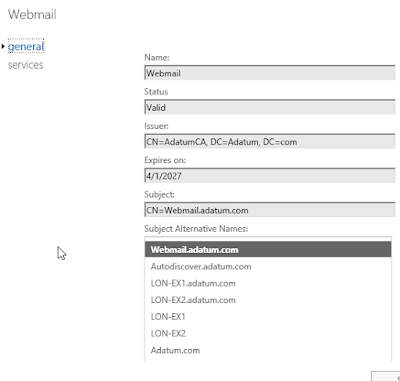All Certificate Names MUST be in Subject Alternative Names
This has been popping up for a while, but it's worth pointing out again. When you get a SAN/UCC certificate, the DNS name that you use for the subject (common name) also needs to be in the subject alternative names attribute.
For example:
It's important to note that the Microsoft CA does not automatically add the subject to the list of subject alternative names. So, make sure that you do it as part of your certificate request for your internal CA.
The reason you need to do this is because of how web browsers are processing subject alternative names. Web browsers are ignoring the subject if a list of subject alternative names is present. All web browsers seem to be enforcing this now. A few years ago, the web browsers would process both the subject and the subject alternative names.
Here's the quote from RFC 2818 from May 2000 (yes, that long ago):
As a slightly interesting side note. The subject field is optional when SANs are defined. However, some older software might still require the subject to be defined.
If you are configuring certificates in Exchange server, be aware that the Exchange admin console (EAC) does not properly differentiate between subject and subject alternative names. In the certificate shown below, webmail.adatum.com is in the subject and not in subject alternative names. EAC (Exchange 2016 CU8) is including the subject in the Subject Alternative Names box which can be misleading.
For example:
- Subject:
- webmail.contoso.com
- Subject alternative names
- webmail.contoso.com
- exch1.contoso.com
- exch2.contoso.com
- Autodiscover.contoso.com
It's important to note that the Microsoft CA does not automatically add the subject to the list of subject alternative names. So, make sure that you do it as part of your certificate request for your internal CA.
The reason you need to do this is because of how web browsers are processing subject alternative names. Web browsers are ignoring the subject if a list of subject alternative names is present. All web browsers seem to be enforcing this now. A few years ago, the web browsers would process both the subject and the subject alternative names.
Here's the quote from RFC 2818 from May 2000 (yes, that long ago):
If a subjectAltName extension of type dNSName is present, that MUST be used as the identity. Otherwise, the (most specific) Common Name field in the Subject field of the certificate MUST be used. Although the use of the Common Name is existing practice, it is deprecated and Certification Authorities are encouraged to use the dNSName instead.
As a slightly interesting side note. The subject field is optional when SANs are defined. However, some older software might still require the subject to be defined.
If you are configuring certificates in Exchange server, be aware that the Exchange admin console (EAC) does not properly differentiate between subject and subject alternative names. In the certificate shown below, webmail.adatum.com is in the subject and not in subject alternative names. EAC (Exchange 2016 CU8) is including the subject in the Subject Alternative Names box which can be misleading.


Comments
Post a Comment